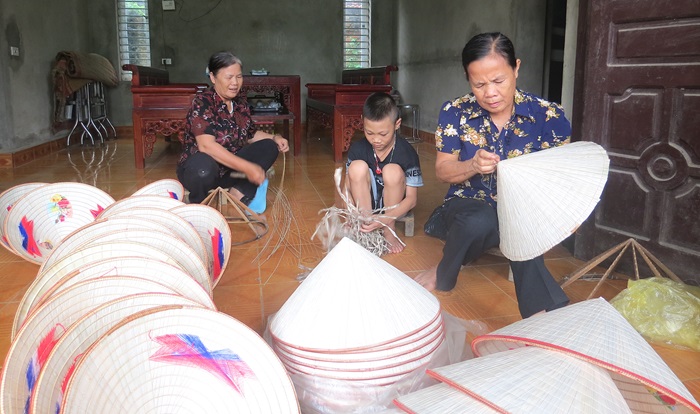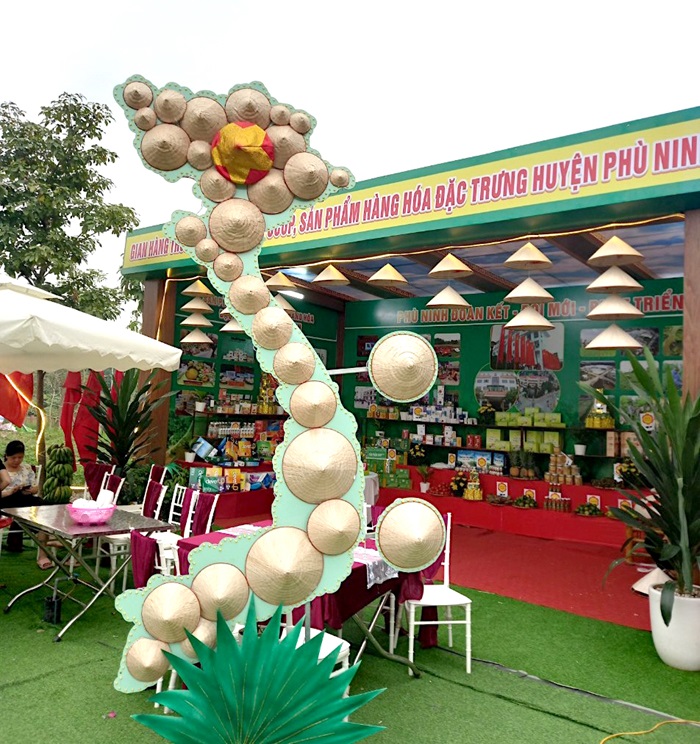The Ancestral Land still preserve many craft villages, of which the conical hat-making craft in Gia Thanh commune, Phu Ninh district, Phu Tho province has a tradition spanning nearly 100 years. Through many generations, the conical hat is still preserved by the people here as a gift from the homeland to friends from near and far. Each conical hat has contributed to preserving and maintaining the traditional cultural features of this countryside.

The conical hat-making craft in Gia Thanh has been passed down from generation to generation.
The late summer showers made the path to Mrs. Nguyen Thi Tich’s house in Zone 4 slippery and more difficult to walk on. Seemingly accustomed to the groups of visitors coming to visit and learn about the conical hat-making craft, while instructing her 8-year-old grandson to roll the leaves, Mrs. Tich quickly sewed a complete conical hat in time to sell at tomorrow’s market.
She said, “This is a traditional craft passed down from our ancestors, so I also want my children and grandchildren to learn to preserve the craft for the future. Everyone in my family, from the old to the young, knows how to make hats. The children help their grandmother roll and iron the leaves; the skilled ones make the rims, put them in the molds, etc. Just like that, the hat-making profession is deeply ingrained in the hearts of every villager in Ren hamlet, enduring over time.”
To make a complete hat requires a lot of effort and meticulousness. The hat maker must perform nearly ten elaborate steps, from rolling the leaves, ironing the leaves, compressing the leaves to make them flat, then making the brim, sewing the hat, etc. The finished hat is removed from the mold, then the thread is cut, the hat is sewn, and the top is sewn. Each Gia Thanh hat is covered with two layers of leaves, with a layer of bamboo between the two layers to create thickness and sturdiness and to prevent it from getting wet in the rain.
The craftsman skillfully threads colored threads on the inside of the hat to tie the strap. Before the hat reaches the buyer, it is coated with a layer of oil to help the hat be durable, beautiful, and waterproof. A beautiful hat must have a flat roof, smooth stitching, and evenly spaced stitches on each brim.
Taking us to visit some hat-making households in the village, Ms. Trieu Thi Nhuong, Head of Gia Thanh Conical Hat Craft Village, shared: “At the end of 2005, people in the commune were excited when the Provincial People’s Committee recognized it as a craft village. Hat-making is mainly concentrated in Zone 3 and Zone 4, with about 40 households. Although the income is not really high, this is a stable profession, contributing to creating jobs for people. From the elderly to children, everyone can make hats in their spare time. Some materials, such as bamboo, reed, bamboo shoots, etc., are taken advantage of by people in their home gardens, thus reducing costs. Therefore, hat weaving is a profession with many advantages compared to other handicrafts”.

Gia Thanh preserves the craft of making conical hats
Gia Thanh conical hat products participated in the exhibition at the Hung Kings’ Death Anniversary-Hung King Temple Festival in 2024.
Not only is it a place to produce a traditional, long-standing handicraft product with typical characteristics, but Gia Thanh conical hat craft village is also a place to preserve the essence of folk art, production experience, and customs of the community. Along with the fairs, Gia Thanh conical hat makers now have more advantages when many people know and come to order because of the durable and beautiful quality of the hats.
Because of this unique feature, in recent years, Gia Thanh conical hats have become an attractive craft village tourism product associated with learning and experiencing local culture, contributing to enhancing economic value and preserving and conserving traditional crafts. The craft village has become a popular destination, especially for international tourists. Thanks to the promotion of tourism, the conical hat has spread far beyond the bamboo fences of the village to all parts of the country and is chosen by many tourists to buy as gifts.
Along with seedless persimmons, the conical hat has become a branded OCOP product of this poor agricultural mountainous commune. To continue to preserve and develop the hat-making profession, in the coming time, the villagers hope that the authorities at all levels will pay more attention to supporting product output, contributing to increasing value and income, thereby motivating the younger generation to stick with it and take the craft village further.
Hong Nhung
Source: Phu Tho Newspaper – en.baophutho.vn – Aug 6, 2024




